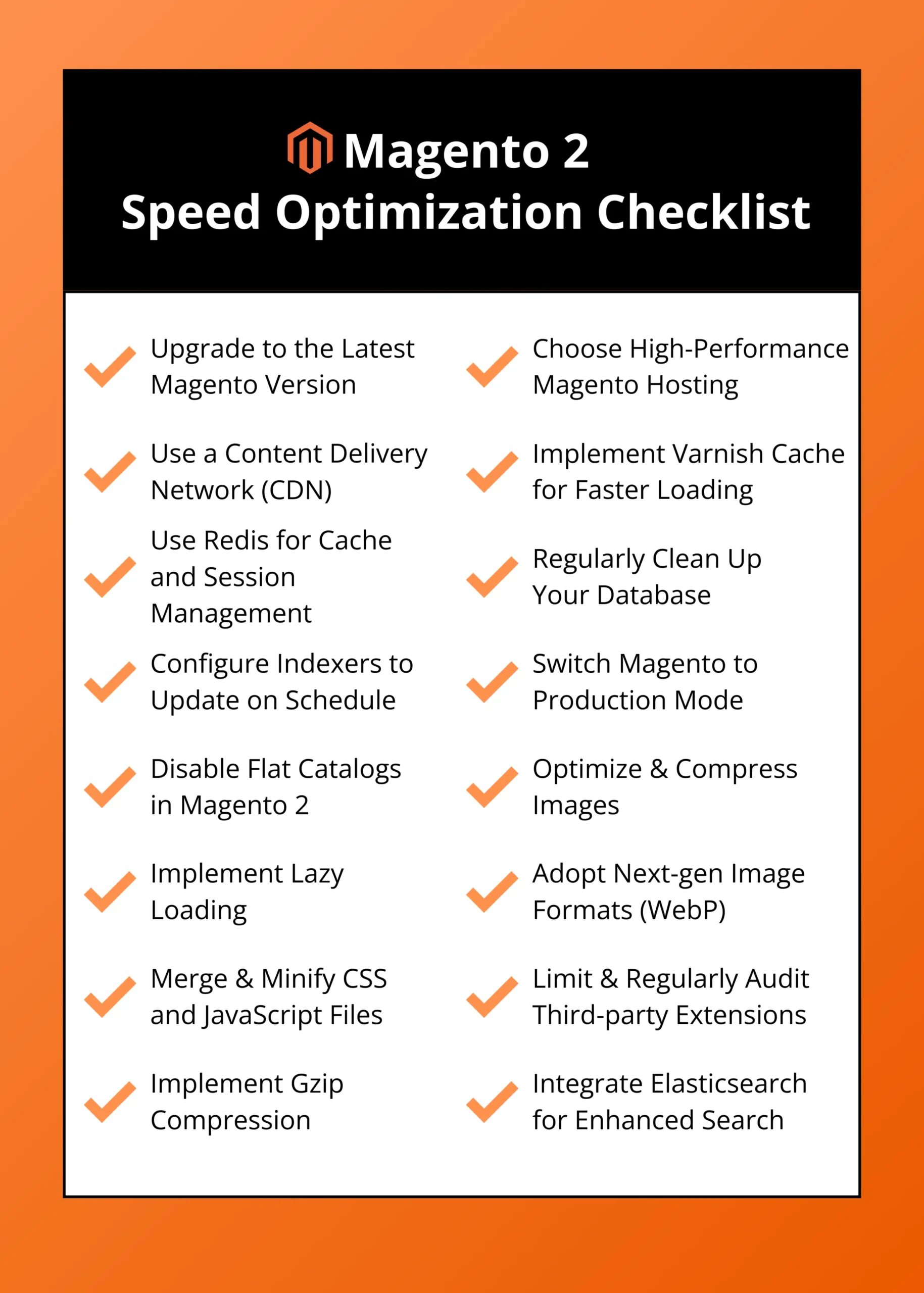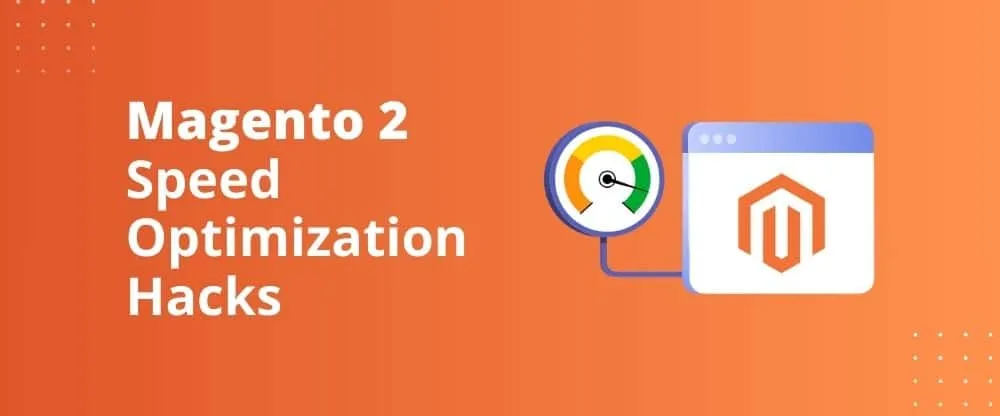



Did you know that just a one-second delay in your Magento store’s load time can cut conversions by up to 7%?
In the fiercely competitive US ecommerce market, every second counts—literally. Your customers expect lightning-fast experiences, and if your Magento 2 store isn't optimized for speed, they're likely to click away and find someone who offers quicker service.
But here's the good news: Magento 2 speed optimization doesn’t have to be complicated.
With the right techniques and regular maintenance, you can boost your store’s speed, enhance user experience, and climb search engine rankings faster than your competition.
In this guide, we'll go through 16 proven and actionable tips to significantly strengthen your Magento store
performance. Whether you're tackling these optimizations in-house or partnering with expert Magento
development services, the results will be measurable and impactful.
Ready to turbocharge your Magento store and turn visitors into loyal customers? Let’s dive in!
Your Magento store’s performance begins at its foundation—your server and hosting environment. No matter how well you've optimized images, code, or themes, slow or unreliable hosting will always hold you back. Here's how to ensure your store has the solid foundation it needs to thrive:
Does it really matter if my Magento store isn't fully up-to-date?
Yes—big time. Each update includes critical speed improvements and security patches. Staying current means faster loading times, fewer vulnerabilities, and happier customers.
Quick takeaway: Schedule regular updates, and consider getting expert help from specialized Magento development services if you need a seamless upgrade.
Can’t I just use any hosting provider for Magento?
Not if speed and reliability matter to you (and they should!). Your hosting provider directly impacts your Magento store’s speed and how well it handles traffic spikes.
Quick takeaway: Opt for Magento-optimized hosting providers such as Nexcess, Cloudways, or AWS, especially when catering to customers across the US.
Why should you care about a CDN?
Because your customers in New York shouldn't wait for content from your server in California. A CDN caches your store’s content closer to your customers’ location, significantly speeding up load times.
Is it complicated?
Not at all! Popular CDN providers like Cloudflare, Akamai, or Fastly integrate effortlessly with Magento.
Quick takeaway: A CDN is essential for effective Magento 2 speed optimization—it's one of your easiest wins for enhancing store speed.
What exactly is Varnish Cache, and why do I need it?
Varnish Cache temporarily saves complete versions of your pages. This means returning visitors experience almost instant page loads, dramatically reducing server load and improving overall speed.
Does it significantly boost my site’s performance?
Absolutely! Implementing Varnish Cache is one of the fastest ways to enhance your Magento store’s performance.
Quick takeaway: If configuration seems daunting, many expert Magento development services offer quick, hassle-free setups.
Your backend and database are like the hidden gears powering your Magento store. Keep them running smoothly, and your customers will feel the difference instantly. Here’s exactly how:
Why bother with Redis? Isn’t the built-in cache enough?
Magento’s default caching can handle smaller loads, but Redis supercharges performance by managing sessions and caching far more efficiently. It dramatically cuts load times, especially during traffic spikes.
Is setting up Redis complicated?
Not really. Redis integrates smoothly with Magento, and many reputable Magento development services can have you set up quickly and effortlessly.
Quick takeaway: Redis is your go-to for efficient caching—especially during peak shopping seasons.
Does database clutter really slow my store down?
Definitely! Over time, your Magento database collects unused logs, outdated records, and abandoned data. These leftovers slow down queries, directly hurting site speed.
What’s the simplest way to handle database cleanup?
Schedule regular database cleanups using built-in Magento tools or extensions like Mageplaza Database Optimization. Keeping it tidy boosts your site’s performance noticeably.
Quick takeaway: Monthly database maintenance can significantly boost your store’s speed and efficiency.
Why is scheduled indexing better than real-time indexing?
Real-time indexing can put unnecessary strain on your server, slowing down your Magento store. Scheduled indexing allows Magento to process data more efficiently without constant interruptions.
How often should indexing happen?
For most stores, indexing every few hours is ideal. High-traffic stores might prefer nightly indexing to minimize performance impact during peak hours.
Quick takeaway: Scheduling indexing is an easy adjustment with big performance benefits.
Optimizing your Magento store doesn’t just stop at servers and databases. Tweaking a few key Magento settings can make a world of difference. Here’s exactly what you should do:
What’s Production Mode, and why should I use it?
Magento has different modes—Developer, Default, and Production. Production Mode delivers the fastest performance by serving optimized, cached content directly to users, reducing load times significantly.
Is switching difficult or risky?
Not at all! Switching modes is straightforward, and you’ll notice immediate performance gains. For extra peace of mind, get assistance from reliable Magento development services.
Quick takeaway: Always run your live store in Production Mode to ensure optimal speed.
Wait, I thought flat catalogs were good?
They were—in older Magento versions. In recent versions (2.1.x and above), flat catalogs can actually slow down indexing and overall performance.
So should I disable it right away?
Yes! If you're running a newer Magento version, disabling flat catalogs boosts indexing efficiency and enhances overall store performance.
Quick takeaway: Disabling flat catalogs in modern Magento stores is a quick, effective optimization.
Your front-end is where customers interact directly with your store—so it needs to load fast and look great. Here’s exactly how to achieve both:
Do images really make that much difference to speed?
Yes! Large, unoptimized images can dramatically slow down your page loading, causing customers to leave before they even get started.
How can I optimize images without losing quality?
Use proven tools or Magento extensions like TinyPNG or Image Optimizer. They compress images effectively without noticeable quality loss.
Quick takeaway: Always optimize images before uploading—it's one of your easiest wins for improving Magento store speed.
What exactly is lazy loading?
Lazy loading delays loading images and media until they actually come into view. That means your page loads quicker initially, giving customers the immediate content they want.
Is it hard to set up in Magento?
Not at all! Magento supports lazy loading through extensions like WeltPixel or Amasty Lazy Load. It’s straightforward and effective.
Quick takeaway: Lazy loading makes pages feel faster instantly—a must-have for modern Magento stores.
What’s WebP, and why does it matter?
WebP is a modern image format developed by Google. It provides smaller file sizes and faster loading without sacrificing image quality.
Is WebP supported in Magento 2?
Absolutely! Magento supports WebP images, and it's easy to integrate via extensions like WebP Optimized Images or through expert Magento development services.
Quick takeaway: Switching to WebP is a smart, future-proof move—your customers (and your SEO rankings) will thank you.
A cluttered codebase or heavy themes and extensions can slow down your Magento store significantly. Here's exactly how you can streamline everything for optimal performance:
What exactly does merging and minifying do?
t reduces the number of HTTP requests and shrinks file sizes by combining multiple CSS or JavaScript files into fewer, smaller files—speeding up how quickly your store loads.
Is it easy to set up in Magento?
Absolutely. Magento 2 has built-in settings to quickly enable CSS and JavaScript merging and minification. Just enable these options in your admin panel.
Quick takeaway: Merging and minifying is an effortless fix that boosts your Magento store's speed noticeably.
Aren’t Magento extensions always helpful?
They can be—but too many extensions can quickly become a heavy burden, negatively impacting your store’s speed.
How do I know which extensions slow me down?
Regular audits using tools like Magento Profiler or hiring professional Magento development services can help identify and remove unnecessary or resource-heavy extensions.
Quick takeaway: Merging and minifying is an effortless fix that boosts your Magento store's speed noticeably.
Why is Gzip compression important?
Gzip compresses web pages and files before they're sent to the browser, significantly reducing load times and bandwidth usage.
How difficult is it to enable Gzip compression?
It's straightforward—your hosting provider often supports it directly, or you can quickly configure it through your server settings.
Quick takeaway: Turning on Gzip compression is a quick, high-impact performance boost you shouldn't skip.
Ready to supercharge your Magento store’s performance to the next level? Here are advanced strategies to stay ahead of your competitors:
Why is Elasticsearch such a big deal for Magento stores?
Elasticsearch drastically speeds up product searches by providing faster, more accurate, real-time results. Customers find exactly what they're looking for instantly—boosting your sales and reducing server load.
Is it complicated to implement Elasticsearch?
Not with Magento 2. It seamlessly integrates, and many specialized Magento development services offer hassle-free setup and fine-tuning.
Quick takeaway: Elasticsearch is essential for larger product catalogs—it's fast, accurate, and customer-approved.

There you have it—16 practical, powerful, and proven ways to optimize your Magento 2 store’s performance. From foundational hosting choices to advanced tools like Elasticsearch, each step you take translates directly into happier customers, better rankings, and higher sales in the competitive US ecommerce market.
Optimizing your store isn’t just technical—it’s strategic. With these tips, you’re now ready to provide the lightning-fast experience your customers expect (and your competitors fear!).
But you don’t have to go it alone…
Still wondering about your next step, or prefer to have seasoned professionals tackle the heavy lifting? Our expert Magento development services team is here to make your life easier. We'll handle the details, so you can focus on
what you do best—growing your business.
Let’s get your Magento store optimized, lightning-fast, and ready for explosive growth.
Talk to Our Magento Experts Today!
Are You Prepared for Digital Transformation?
Magento Development
Make your Adobe Commerce store faster and smoother with Optimizer—boost speed, stability, and sales without rebuilding your site.
Magento Development
Magento is one of the most popular e‐commerce carts, which presently enjoys a market share of around 30 percent. In fact, it has recorded a 60 % higher growth in the year 2014 as compared to the year 2013. Besides, it is a highly scalable, secure, and robust system known for its flexibility…
Magento Development
Magento is one of the most popular content management systems used by eCommerce companies. Millions of global eCommerce websites, whether small or big, are based on Magento. Magento platform enjoys 26 percent share in the global market. It offers almost all features needed to successfully run an eCommerce…